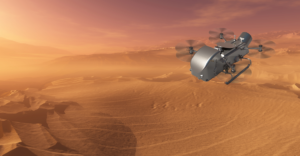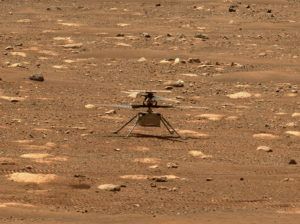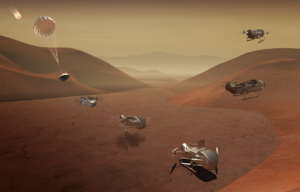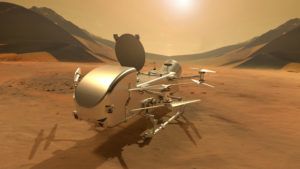Words by Paul Willis
This past April Ingenuity, a NASA helicopter sent to Mars as part of the Mars 2020 mission, made its 50th flight on the Red Planet. The flight capped a remarkable two years for the small craft, which flew for the first time on Mars on April 2021, in a 39-second trip that marked the first powered and controlled flight of a rotorcraft on another planet.
Since then, Ingenuity has far exceeded the expectations of its developers, who intended it to be a technology demonstration designed for just five flights on the martian surface. Key among those engineers is Bob Balaram, the originator of the Ingenuity concept and the chief engineer during its development, test and martian operations.
Balaram is understandably proud of what the Ingenuity mission has achieved. “It is really cool to look up in the night sky and see the little red dot of Mars and to think that somewhere on that is our little helicopter, which our team put together,” he says.
It is hard to overstate what an extraordinary feat of engineering it was to turn Balaram’s idea into a reality, and in the annals of space exploration Ingenuity could well prove a watershed moment. As Balaram puts it, Ingenuity has “opened the door” to future unmanned flight on other planets.
In the case of Mars, NASA plans to send two more helicopters to the planet as a part of a sample-return mission provisionally scheduled for 2026. Another NASA mission slated to launch the following year in 2027 is Dragonfly, a 450kg (990 lbs) rotorcraft that will be used to explore Saturn’s moon Titan for signs of life.
Dragonfly

Far larger than Ingenuity, which weighs just 1.8kg, Dragonfly’s developers have big ambitions. The helicopter will be a mobile science laboratory, touching down at different locations on Titan to study the prebiotic chemistry present on the surface of this distant moon.
Ralph Lorenz is Dragonfly mission architect and a planetary scientist and engineer at the Johns Hopkins Applied Physics Lab (APL), which is leading the development of Dragonfly for NASA. He says that the major differences between Ingenuity’s and Dragonfly’s mission goals and the environments they will be operating in mean “there is little or no heritage in the hardware”. Nevertheless he and his team are drawing on lessons from the operations of Ingenuity. Several Ingenuity team members have served in a consultative role to Dragonfly.
Balaram first got the idea for a helicopter flight on Mars back in the 1990s though he admits he wasn’t the only one. “The American Helicopter Society even held a competition where university students could design a helicopter for Mars,” says Balaram. “This was around the time NASA’s Pathfinder mission landed on Mars with the little Sojourner rover [1997]. So there was a lot of excitement about Mars at that time.”
Even so, the concept sat on the shelf for the next 15 years until interest in then nascent drone technology led to Balaram being asked to produce a brief detailing the technology’s feasibility for a Mars mission. “They gave us some seed money and we designed and built Ingenuity,” says Balaram.
Design development

Balaram and his team had to overcome some complex challenges, the most significant of which was the extremely thin atmosphere on Mars. Air density on Mars is about 1% of the air density at sea level on Earth.
This makes creating uplift for take-off much harder. While the lower martian gravitational pull, which is about a third of Earth’s helps somewhat “you’re still fighting with a very low density,” says Balaram.
Consequently, for Ingenuity to become airborne the priority was to make it as lightweight as possible. However, this design criteria clashed with another – to make the craft robust enough to survive in the extraordinarily hostile environments on Mars.
According to Balaram, this meant making it strong enough to withstand both the rigors of launch where vibrational loads can reach as high as 18 gs. It also has to deal with the vacuum and radiation of space, the vibrational loads during descent on to Mars and the extreme cold of Mars itself where temperatures can drop as low as minus 90˚C during the night.
The thinness of Mars’ atmosphere also created problems for the control of the aircraft, he says.
“On Earth, the thickness of the atmosphere helps to damp out certain unwanted motions in helicopter blades. On Mars you don’t have that damping effect so we had some stability issues that we had to overcome.
“You need a lot of high performance computing to keep essentially what’s an unstable vehicle in the air. NASA had old-fashioned processors, which were radiation-tolerant but didn’t have the computing power required. So we had to look elsewhere for commercial-off-the-shelf solutions.”
Extreme cold

While Dragonfly will face many significant challenges during its Titan mission, getting airborne shouldn’t be one of them. Titan’s dense atmosphere – four times denser than Earth’s – should make flying easy.
So easy says Balaram, that a human being with a pair of wings could get airborne by simply flapping their arms “if they didn’t mind the cold”.
This is an important caveat on a celestial body where surface temperatures average out at around -179˚C (-290˚F). The extreme cold in fact is likely to be one of the most challenging aspects of the Dragonfly mission, says Lorenz.
“A significant challenge is the low temperature, which obliges us to use careful thermal design,” he says.
Lorenz is also anticipating challenges to Dragonfly’s on-board hazard detection sensors from the gas composition of Titan’s atmosphere, which like Earth’s
is dominated by nitrogen but also contains about 5% methane.
“Some lidars use lasers at wavelengths that methane in Titan’s atmosphere would absorb, so we have to make sure our devices use wavelengths better matched to Titan’s conditions,” says Lorenz.
The testing program for the eight-rotor Dragonfly will focus on assessing how the craft will cope with conditions on this distant moon. Lorenz and his team at APL have constructed a dedicated 3m (10ft) diameter test chamber where Titan’s atmospheric pressure and composition can be carefully reproduced.
They are also in the process of commissioning a thermal test chamber which will be “big enough to put the whole lander in.”
Into the unknown

Unlike Ingenuity, which was flown to Mars as part of a much bigger payload, Dragonfly will touch down alone on Titan after an eight year journey through space. The spacecraft will be parachuted down and then fly under its own propulsion to a landing site.
According to Lorenz, this first landing on Titan “will certainly involve the most unknowns since we will not have the benefit of images from Dragonfly beforehand”. Instead the team will have to rely on data about Titan’s surface gleaned from the Cassini mission, a joint European-USA space probe that orbited Saturn for 13 years until 2017.
Another significant difference compared to Ingenuity are the mission goals. While it has operated as a reconnaissance scout for the Perseverance rover, Ingenuity was created to be a technology demonstration and as such its brief was relatively simple – to prove that unmanned flight was possible on another planet.
However, Dragonfly will fly its entire science payload inside the craft, so that it can go to different locations on the planet to conduct tests of the surface materials.
“What we are doing is land-based exploration – Dragonfly is just a lander that can be relocated by flight,” says Lorenz. “It allows us to transition from one site of interest to another much further and faster than a rover could.”
Another major challenge will be maintaining communication with the helicopter, essential both for relaying flight instructions and for receiving data collected during its science research. It takes an hour for communications to reach Titan from Earth, and the ability to communicate is highly circumscribed by the duration of the Titan day cycle, which lasts nearly 16 Earth days.
According to Lorenz all of Dragonfly’s flights will be conducted “while in communication with Earth, so we will have a continuous indication that the flight is going to plan”.
He adds: “After a given landing, it will probably be 15 minutes or so after we let the dust clear and get the high-gain antenna pointed at Earth to start beaming back more voluminous data such as images.
“But it will take days for all the data from a flight to come back.”
Dragonfly recently passed its preliminary design review, and Lorenz and his team have begun building the engineering model (EM) of the craft’s systems. These “are the same design, form and function as what we expect to fly with, for testing and we have already been doing outdoor flight tests with a half-scale octocopter, which is our integrated test platform for some years,” Lorenz says.
All the EM units will be tested together in a flatsat tabletop layout, and “there are separate full-scale models that are more geometrically representative” for other types of testing. While the Titan mission will be different to Ingenuity, the earlier mission is an important step, says Balaram. “Ingenuity has already flown on another planet,” says Balaram. “So that step into the unknown has been taken. Psychologically, I think that’s not unimportant.”
Searching for life on Saturn’s moon

NASA’s Dragonfly rotorcraft will touch down on Titan during the mid-2030s. Getting there will take eight strenuous years of traveling 746 million miles through the vacuum of space.
Given the incredible difficulties posed by this mission the obvious question to ask is, why Titan?
According to Melissa Trainer, deputy principal investigator at NASA’s Goddard Space Flight Center and part of the Dragonfly mission, space scientists’ interest in Titan stems from its classification as an ocean world, one where water is thought to be present in large volumes.
In the case of Titan, its oceans are believed to be locked tens of kilometers below the moon’s icy surface. The evidence for this sub-surface ocean comes from gravity and inertial measurements taken by the Cassini orbiter, says Trainer. The sub-surface density implied by these measurements suggests the presence of water, she says.
They also point to “a decoupling between the exterior and the interior, which implies that you have a liquid layer in between, and that based on where we are in the solar system that liquid layer would have to be mostly water,” she says.
The other important characteristic of Titan is “the immense amount of organic material that is in its atmosphere and on its surface,” says Trainer.
Scientists believe that it’s highly likely that at different periods in the moon’s history this organic material will have come into contact with water that was brought to the surface either through eruptions or through impact events. This combination of water and complex organic matter is thought to be one of the primary conditions for the creation of molecules like amino acids, one of the building blocks of life.
Dragonfly will visit many of the surface locations where scientists suspect this kind of interaction may have taken place to search for the conditions that led to the formation of life, known as prebiotic chemistry. To do this it will drill tiny samples from Titan’s surface. The samples will be brought inside the lander’s body where a mass spectrometer will be used to analyze their chemical makeup.





